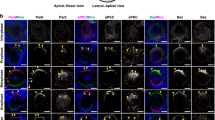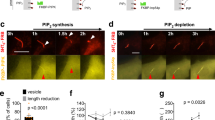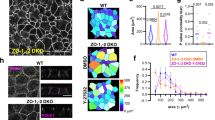Abstract
The par (partitioning-defective) genes express a set of conserved proteins that function in polarization and asymmetric cell division1,2. Par-3 has multiple protein-interaction domains, and associates with Par-6 and atypical protein kinase C (aPKC)3,4,5. In Drosophila, Par-3 is essential for epithelial cell polarization6. However, its function in mammals is unclear. Here we show that depletion of Par-3 in mammalian epithelial cells profoundly disrupts tight junction assembly. Expression of a carboxy-terminal fragment plus the third PDZ domain of Par-3 partially rescues junction assembly, but neither Par-6 nor aPKC binding is required. Unexpectedly, Rac is constitutively activated in cells lacking Par-3, and the assembly of tight junctions is efficiently restored by a dominant-negative Rac mutant. The Rac exchange factor Tiam1 (ref. 7) binds directly to the carboxy-terminal region of Par-3, and knockdown of Tiam1 enhances tight junction formation in cells lacking Par-3. These results define a critical function for Par-3 in tight junction assembly, and reveal a novel mechanism through which Par-3 engages in the spatial regulation of Rac activity and establishment of epithelial polarity.
This is a preview of subscription content, access via your institution
Access options
Subscribe to this journal
Receive 12 print issues and online access
$209.00 per year
only $17.42 per issue
Buy this article
- Purchase on Springer Link
- Instant access to full article PDF
Prices may be subject to local taxes which are calculated during checkout





Similar content being viewed by others
References
Kemphues, K. J., Priess, J. R., Morton, D. G. & Cheng, N. S. Identification of genes required for cytoplasmic localization in early C. elegans embryos. Cell 52, 311–320 (1988).
Doe, C. Q. & Bowerman, B. Asymmetric cell division: fly neuroblast meets worm zygote. Curr. Opin. Cell Biol. 13, 68–75 (2001).
Izumi, Y. et al. An atypical PKC directly associates and colocalizes at the epithelial tight junction with ASIP, a mammalian homologue of Caenorhabditis elegans polarity protein PAR-3. J. Cell Biol. 143, 95–106 (1998).
Joberty, G., Petersen, C., Gao, L. & Macara, I. G. The cell-polarity protein Par6 links Par3 and atypical protein kinase C to Cdc42. Nature Cell Biol. 2, 531–539 (2000).
Lin, D. et al. A mammalian PAR-3–PAR-6 complex implicated in Cdc42/Rac1 and aPKC signalling and cell polarity. Nature Cell Biol. 2, 540–547 (2000).
Tepass, U., Tanentzapf, G., Ward, R. & Fehon, R. Epithelial cell polarity and cell junctions in Drosophila. Annu. Rev. Genet. 35, 747–784 (2001).
Mertens, A. E., Roovers, R. C. & Collard, J. G. Regulation of Tiam1–Rac signalling. FEBS Lett. 546, 11–16 (2003).
Macara, I. G. Parsing the polarity code. Nature Rev. Mol. Cell Biol. 5, 220–231 (2004).
Nelson, W. J. Adaptation of core mechanisms to generate cell polarity. Nature 422, 766–774 (2003).
Perez-Moreno, M., Jamora, C. & Fuchs, E. Sticky business: orchestrating cellular signals at adherens junctions. Cell 112, 535–548 (2003).
Gibson, M. C. & Perrimon, N. Apicobasal polarization: epithelial form and function. Curr. Opin. Cell Biol. 15, 747–752 (2003).
Hirose, T. et al. Involvement of ASIP/PAR-3 in the promotion of epithelial tight junction formation. J. Cell Sci. 115, 2485–2495 (2002).
Matter, K. & Balda, M. S. Functional analysis of tight junctions. Methods 30, 228–234 (2003).
Furuse, M., Furuse, K., Sasaki, H. & Tsukita, S. Conversion of zonulae occludentes from tight to leaky strand type by introducing claudin-2 into Madin-Darby canine kidney I cells. J. Cell Biol. 153, 263–272 (2001).
Gao, L., Joberty, G. & Macara, I. G. Assembly of epithelial tight junctions is negatively regulated by Par6. Curr. Biol. 12, 221–225 (2002).
Benton, R. & Johnston, D. S. A conserved oligomerization domain in Drosophila Bazooka/PAR-3 is important for apical localization and epithelial polarity. Curr. Biol. 13, 1330–1334 (2003).
Mizuno, K. et al. Self-association of PAR-3-mediated by the conserved N-terminal domain contributes to the development of epithelial tight junctions. J. Biol. Chem. 278, 31240–31250 (2003).
Wodarz, A., Ramrath, A., Grimm, A. & Knust, E. Drosophila atypical protein kinase C associates with Bazooka and controls polarity of epithelia and neuroblasts. J. Cell Biol. 150, 1361–1374 (2000).
Ebnet, K. et al. The cell polarity protein ASIP/PAR-3 directly associates with junctional adhesion molecule (JAM). EMBO J. 20, 3738–3748 (2001).
Takekuni, K. et al. Direct binding of cell polarity protein PAR-3 to cell–cell adhesion molecule nectin at neuroepithelial cells of developing mouse. J. Biol. Chem. 278, 5497–5500 (2003).
Kovacs, M., Toth, J., Hetenyi, C., Malnasi-Csizmadia, A. & Sellers, J. R. Mechanism of blebbistatin inhibition of myosin II. J. Biol. Chem. 279, 35557–35563 (2004).
Kosako, H. et al. Rho-kinase/ROCK is involved in cytokinesis through the phosphorylation of myosin light chain and not ezrin/radixin/moesin proteins at the cleavage furrow. Oncogene 19, 6059–6064 (2000).
Totsukawa, G. et al. Distinct roles of ROCK (Rho-kinase) and MLCK in spatial regulation of MLC phosphorylation for assembly of stress fibres and focal adhesions in 3T3 fibroblasts. J. Cell Biol. 150, 797–806 (2000).
Noren, N. K., Niessen, C. M., Gumbiner, B. M. & Burridge, K. Cadherin engagement regulates Rho family GTPases. J. Biol. Chem. 276, 33305–33308 (2001).
Malliri, A., van Es, S., Huveneers, S. & Collard, J. G. The Rac exchange factor Tiam1 is required for the establishment and maintenance of cadherin-based adhesions. J. Biol. Chem. 279, 30092–30098 (2004).
Stam, J. C. et al. Targeting of Tiam1 to the plasma membrane requires the cooperative function of the N-terminal pleckstrin homology domain and an adjacent protein interaction domain. J. Biol. Chem. 272, 28447–28454 (1997).
Knoblich, J. A. Asymmetric cell division during animal development. Nature Rev. Mol. Cell Biol. 2, 11–20 (2001).
Jan, Y. N. & Jan, L. Y. Asymmetric cell division in the Drosophila nervous system. Nature Rev. Neurosci. 2, 772–779 (2001).
Brummelkamp, T. R., Bernards, R. & Agami, R. A system for stable expression of short interfering RNAs in mammalian cells. Science 296, 550–553 (2002).
Ren, X. D. & Schwartz, M. A. Determination of GTP loading on Rho. Methods Enzymol. 325, 264–272 (2000).
Acknowledgements
We thank J. G. Collard for providing Tiam1 C1199 plasmid and anti-Tiam1 antibody, M. A. Schwartz for pGEX-RBD and pGEX-PBD plasmids, and A. Spang (Tübingen) and members of the Macara laboratory for helpful comments. This work was supported by grants GM070902 and CA40042 from the National Institutes of Health, DHHS.
Author information
Authors and Affiliations
Corresponding author
Ethics declarations
Competing interests
The authors declare no competing financial interests.
Supplementary information
Supplementary information
Supplementary figures S1, S2 and S3 (PDF 554 kb)
Rights and permissions
About this article
Cite this article
Chen, X., Macara, I. Par-3 controls tight junction assembly through the Rac exchange factor Tiam1. Nat Cell Biol 7, 262–269 (2005). https://doi.org/10.1038/ncb1226
Received:
Accepted:
Published:
Issue Date:
DOI: https://doi.org/10.1038/ncb1226
This article is cited by
-
Hypoxia disrupt tight junctions and promote metastasis of oral squamous cell carcinoma via loss of par3
Cancer Cell International (2023)
-
TMEM25 is a Par3-binding protein that attenuates claudin assembly during tight junction development
EMBO Reports (2023)
-
Pancreatic β-cell heterogeneity in adult human islets and stem cell-derived islets
Cellular and Molecular Life Sciences (2023)
-
Pals1 functions in redundancy with SMAP1 to inhibit Arf6 in order to prevent Rac1-dependent colorectal cancer cell migration and invasion
Cancer Gene Therapy (2022)
-
Integrative proteogenomic characterization of hepatocellular carcinoma across etiologies and stages
Nature Communications (2022)



